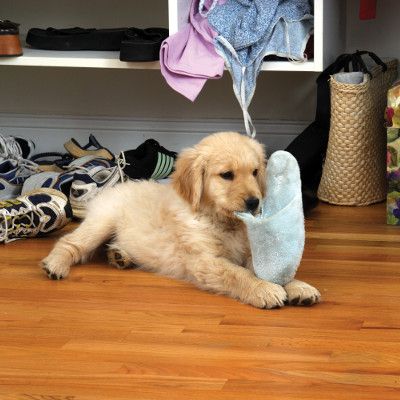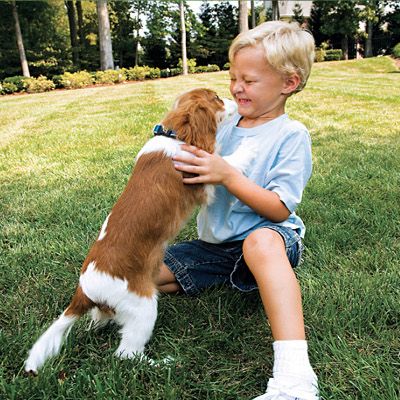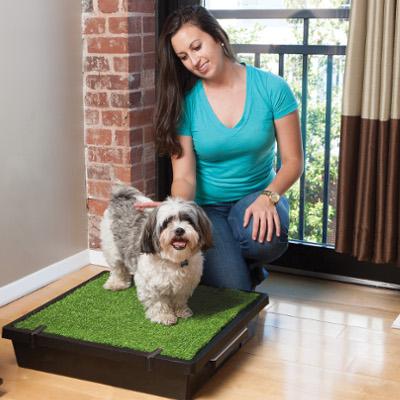 Your puppy is learning whether you teach him or not! Because you are working on a clean slate, it's much easier to teach him what you want as soon as he comes into your home rather than having to erase something he has already learned and then change it to what you want him to do.
Your puppy is learning whether you teach him or not! Because you are working on a clean slate, it's much easier to teach him what you want as soon as he comes into your home rather than having to erase something he has already learned and then change it to what you want him to do.
There are 2 categories of training - one is how you would like him to behave in everyday life, called social training, and the other is teaching him what you want him to do when you tell him, which is obedience training. As a young puppy, he will be learning concepts of whatever you train until he learns the end result, which comes as he matures both physically and mentally.
What Can You Teach Your Puppy When He First Arrives in Your Home?
Where most people start is with potty training because no one likes to clean up pee and poop! Begin by teaching him where you want him to go when he has to go, which may be tricky because he does not have a great deal of control of his body. His body tells him he has to go NOW. Even though you may want him to toilet in a certain area, he just doesn't have the muscle control to hold it. Keep a diary so you know when he has to go so you can take him to the right place when you know he needs to go.
 The next phase of his training is chewing and biting. For chewing, you can help your puppy along by providing "legal" chew toys to minimize his chewing on "illegal" things such as your body parts, the furniture, etc. Rather than feeding him from a bowl, feed him from food-dispensing toys so he has to work to get food out and uses up most of his "daily chewing quota" on the toys.
The next phase of his training is chewing and biting. For chewing, you can help your puppy along by providing "legal" chew toys to minimize his chewing on "illegal" things such as your body parts, the furniture, etc. Rather than feeding him from a bowl, feed him from food-dispensing toys so he has to work to get food out and uses up most of his "daily chewing quota" on the toys.
Regarding biting, he began learning bite inhibition from his littermates by playing with them - if he bit them too hard, they screamed and walked away because they didn't want him to hurt them again. He continues to learn how to regulate the intensity of his bite by your giving him humane feedback.
People's skin is more sensitive than puppies' skin since people don't have skin covered with fur as do puppies. He has to learn he can't bite us as hard as he did his brothers and sisters. Don't play with him with your body parts, i.e., your hands and feet, if you don't want them to get bitten! Always have a toy handy. For the inevitable time when he bites too hard, simply scream "ouch" and get up and leave the room. He will soon find out that his best friend - you - has delicate skin and you don't want him to hurt you just as his littermates did not want to him to hurt them.
 How Can You Tell If Your Puppy Is Ready to Start Training?
How Can You Tell If Your Puppy Is Ready to Start Training?
Generally speaking, puppies are like sponges and are eager to learn whatever you teach them. If you have been lucky, your breeder or shelter had already begun teaching her puppies simple obedience exercises such as Sit.
Most of the time, new puppy parents are so overwhelmed with simply taking care of the puppy's everyday needs (just like babies, puppies are a lot of work!) that they can't even think about training commands. But obedience is something to start as soon as you can because it's a communication tool that lets your puppy know what you want him to do. Otherwise, he is going to do what comes naturally to him, which is something you don't want him to do.
When Can You Start Training Your Puppy Obedience Commands Like Sit, Stay, and Come?
 Sit and Come are pretty easy to teach a puppy. That doesn't mean that your puppy will be 100% reliable, because he has the attention span of a gnat! But you can start training those fairly soon.
Sit and Come are pretty easy to teach a puppy. That doesn't mean that your puppy will be 100% reliable, because he has the attention span of a gnat! But you can start training those fairly soon.
To train both of them, you can "capture" the behavior as it happens and just put your command to it. In other words, say Sit when he begins to sit and Come as he begins to walk towards you. With several repetitions, he will start associating the word you are saying with whatever action he is doing.
Teaching Stay is more difficult because of his short attention span, so he needs to be rewarded every nanosecond he stays. Give him a treat every second he is sitting and tell him what a good dog he is. Then give him a release word, turn your back, and walk away to end the command.
Remember that he is a puppy whose mind and body are developing at an astronomical rate. The first 6 months of his life are equivalent to 12 years in a human's life, so every day he is learning hundreds if not thousands of new things. Because you are patient and consistent with training, he will learn what you want him to do, and you and your puppy will have an enjoyable life together.








